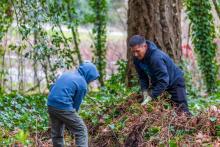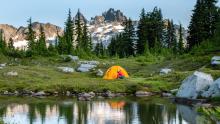A waterfront park, located along the Duwamish Waterway in South Elliott Bay, offers a window into Seattle’s history and a vision for a sustainable future.
The Port of Seattle acquired this shoreline site in the late 1960s for industrial development. But the plans were waylaid when shells, bones of fish and birds, and cultural materials were unearthed. The former industrial area, cluttered with derelict structures and thousands of tons of concrete debris, lay fallow for the next 15 years. In the mid-1990s, the Port of Seattle cleaned up the site and opened the Terminal 107 park to public access as part of an ongoing initiative to balance commerce, community and the environment.
“As we develop our industrial sites, part of what we do is also supply public access to the water,” says Stephanie Jones Stebbins, Director, Seaport Environmental and Planning for the Port of Seattle. “This organization was about developing commerce in the beginning, and now the mission has expanded to reflect community and environmental values. It’s all about balance."
Walk back in time
The 7-acre shoreline-access park provides a quiet green open space in south Elliott Bay. It also offers visitors a glimpse of rich cultural history through multiple interpretive and art installations located along nearly 4000 linear feet of level access pathways winding through restored landscaped areas.
Two art installations describe the park’s context. A vertical cast-metal timeline describes the site’s geographic and cultural change over thousands of years. An elevated boat sculpture with interpretive panels notes that ancestors of the Duwamish Tribe inhabited the site for at least 1,400 years, fishing the rich river for salmon. Pioneer John Pike bought the land from the U.S. government in 1860. Later, European immigrants arrived, and fishing boats were crafted at local shipyards. The 5/8-scale boat sculpture depicts a North Pacific halibut schooner, recalling that fishing boats were built here during the early part of the 20th century.
Local community helps keep Terminal 107 clean and green
Even after Terminal 107 Park opened in 1998 there was still a lot of work to be done. The shoreline was choked with invasive plants and native trees, shrubs, and marsh had disappeared during decades of neglect.
The Port of Seattle partnered with EarthCorps, a local nonprofit that spearheads a steward program of volunteers to sustain and restore public parks in the Puget Sound. Four EarthCorps stewards go to Terminal 107 once a month and run events typically attended by 5 to 15 extra volunteers.
“It’s exciting for us to work with the Port of Seattle,” says Mariska Kecskes, Project Manager, Volunteer Services for EarthCorps. “Their commitment to establishing a balance between industry and public green spaces along the Duwamish is forward-thinking and inspiring.
Volunteer efforts are focused on removing invasive species along the shoreline of the park and re-establishing native species. They’ve been focusing on grassy marsh plants for the past decade. The restoration efforts have been so successful that now they’re moving inland and focusing on native shrubs and trees.
The Port’s marine maintenance department uses 100 percent organic landscaping techniques and plants only native, noninvasive species and drought-tolerant trees and shrubs in all of its 19 parks. All grass clippings and trimmed branches are composted or mulched for future use. This helps to conserve water and reduce run-off. Several parks have received environmental awards for recycling, water conservation and hazardous waste reduction. The Port of Seattle Terminal 107 park has become a vital and thriving wildlife habitat, home to great blue heron, osprey, waterfowl, salmon and harbor seals.
“We’ve seen an amazing transformation from an industrial wasteland, brambles and weeds, into a highly usable park,” says George Blomberg, Senior Environmental Program Manager for the Port of Seattle. “It’s a growing project, and keeps getting better with the help of our landscape crew and local volunteers. Not only does this park have a fascinating past, but it also has a hopeful future.”






